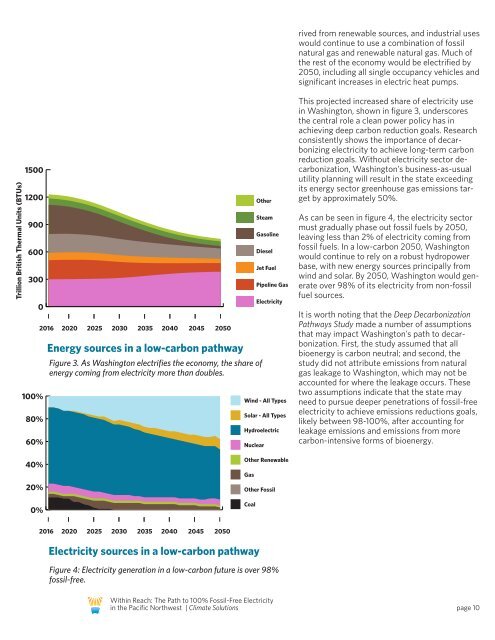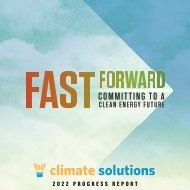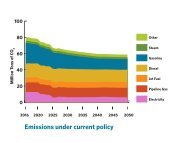within reach - 04
within reach - 04
within reach - 04
You also want an ePaper? Increase the reach of your titles
YUMPU automatically turns print PDFs into web optimized ePapers that Google loves.
ived from renewable sources, and industrial uses<br />
would continue to use a combination of fossil<br />
natural gas and renewable natural gas. Much of<br />
the rest of the economy would be electrified by<br />
2050, including all single occupancy vehicles and<br />
significant increases in electric heat pumps.<br />
Trillion British Thermal Units (BTUs)<br />
1500<br />
1200<br />
900<br />
600<br />
300<br />
0<br />
100%<br />
80%<br />
60%<br />
2016 2020 2025 2030 2035 2<strong>04</strong>0 2<strong>04</strong>5 2050<br />
Energy sources in a low-carbon pathway<br />
Figure 3. As Washington electrifies the economy, the share of<br />
energy coming from electricity more than doubles.<br />
Other<br />
Steam<br />
Gasoline<br />
Diesel<br />
Jet Fuel<br />
Pipeline Gas<br />
Electricity<br />
Wind - All Types<br />
Solar - All Types<br />
Hydroelectric<br />
Nuclear<br />
This projected increased share of electricity use<br />
in Washington, shown in figure 3, underscores<br />
the central role a clean power policy has in<br />
achieving deep carbon reduction goals. Research<br />
consistently shows the importance of decarbonizing<br />
electricity to achieve long-term carbon<br />
reduction goals. Without electricity sector decarbonization,<br />
Washington’s business-as-usual<br />
utility planning will result in the state exceeding<br />
its energy sector greenhouse gas emissions target<br />
by approximately 50%.<br />
As can be seen in figure 4, the electricity sector<br />
must gradually phase out fossil fuels by 2050,<br />
leaving less than 2% of electricity coming from<br />
fossil fuels. In a low-carbon 2050, Washington<br />
would continue to rely on a robust hydropower<br />
base, with new energy sources principally from<br />
wind and solar. By 2050, Washington would generate<br />
over 98% of its electricity from non-fossil<br />
fuel sources.<br />
It is worth noting that the Deep Decarbonization<br />
Pathways Study made a number of assumptions<br />
that may impact Washington’s path to decarbonization.<br />
First, the study assumed that all<br />
bioenergy is carbon neutral; and second, the<br />
study did not attribute emissions from natural<br />
gas leakage to Washington, which may not be<br />
accounted for where the leakage occurs. These<br />
two assumptions indicate that the state may<br />
need to pursue deeper penetrations of fossil-free<br />
electricity to achieve emissions reductions goals,<br />
likely between 98-100%, after accounting for<br />
leakage emissions and emissions from more<br />
carbon-intensive forms of bioenergy.<br />
40%<br />
20%<br />
0%<br />
Other Renewable<br />
Gas<br />
Other Fossil<br />
Coal<br />
2016 2020 2025 2030 2035 2<strong>04</strong>0 2<strong>04</strong>5 2050<br />
Electricity sources in a low-carbon pathway<br />
Figure 4: Electricity generation in a low-carbon future is over 98%<br />
fossil-free.<br />
climate solutions<br />
Within Reach: The Path to 100% Fossil-Free Electricity<br />
accelerating in the the Pacific transition to Northwest our clean energy future | Climate Solutions<br />
page 10








